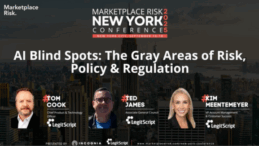The Marketplace Risk Global Summit, which took place this month in London, provided a space for the experts, founders, and industry leaders of online platforms to share their experiences, strategies, and forward-thinking solutions to the most pressing challenges in risk management, trust & safety, compliance, and more.
Keep reading to learn more about the most important issues discussed at this year’s global summit.

November 14, 2025 | by LegitScript Folks
AI Is Equally a Challenge and an Opportunity
The majority of sessions at this year’s global conference touched upon artificial intelligence and its evolving impact on online platforms, both for better and for worse. As AI becomes more sophisticated, it is enabling new forms of fraud and problematic user behavior that are increasingly difficult to identify. But the technology is also leading to advanced tools that make risk detection faster and more accurate.
Some of the AI challenges experts discussed included:
- AI-generated images. On e-commerce marketplaces, sellers are increasingly using AI to modify product images. It’s challenging to create policy that differentiates between harmless modification that may enhance a listing and malicious modification that seeks to deceive or defraud buyers.
- AI-generated deepfakes. Videos and images generated by AI are being used to trick systems meant to verify a user’s identity, such as facial recognition software. Panelists discussed ways to combat this fraud and also employ additional safeguards.
- AI adult content: As AI-generated pornography begins to flood the internet, panelists discussed the complexities around getting consent from real people who may be depicted in this content. Experts also discussed the challenges of ensuring child safety in an environment where this content is easy to create and access.
Some of the AI opportunities discussed included:
- AI-powered onboarding and verification. Just as new tools are being used to trick seller onboarding and user verification, AI is also the best equipped to catch this kind of behavior. Fraudsters and risk teams are always in a technological arms race, and it will be increasingly necessary for platforms to use AI tools to vet sellers and users.
- AI-powered monitoring. New AI-powered monitoring tools are providing scalable solutions that are faster and more accurate than previous automated solutions. They can also provide analysis and context in a way previously unavailable at scale.
- AI for data analysis. AI excels at ingesting and analyzing massive amounts of data. For platforms that engage in data sharing, AI may be able to help them more quickly detect fraud trends across the ecosystem.
Although Regulations Vary Globally, Underlying Challenges Are Similar
A number of sessions focused on regulations and how to successfully navigate them in a fast-paced environment that is increasingly competitive. Over-regulation threatens to suppress innovation, and platforms must learn to skillfully balance compliance with growth. To find the right balance, platforms need to track new regulations, understand enforcement actions, and untangle sometimes nebulous laws. The most successful platforms are in touch with regulators, working in partnership with them to ensure satisfactory compliance with laws. These relationships may also empower platforms to help inform future regulations.
While regulations around the world vary, e-commerce marketplaces generally struggle with similar compliance issues, including: problematic products appearing on their platforms, miscategorization of products (either inadvertently or intentionally), and broadly defined laws that allow room for interpretation. Consulting with policy experts to understand specific risk landscapes can help platforms craft better policy.
Trust and Safety Deserves Better Integration Into Company Processes
A number of panelists lamented that trust and safety teams are often seen by the rest of their companies as the “department of no.” They are sometimes viewed by co-workers as the ones who delay projects and staunch creativity in the name of compliance and safety. This is a fundamental marketing and PR problem that trust and safety departments need to address so that the rest of the company can appreciate their work and understand the vital role it plays in the success of the business.
Some ideas proposed by panelists included:
- Use the marketing team. Whenever you have new initiatives or interesting case studies that highlight your work, reach out to the marketing department for help in communicating these messages. They are experts at crafting narratives and can help you showcase what your team does.
- Join other departments’ meetings. For other departments impacted by trust and safety, ask to join their meetings to stay abreast of their work. You’ll better understand their priorities and their metrics for success, which can differ from yours. Furthermore, you may be able to offer insight from a compliance perspective.
- Contribute to the product roadmap early. Stay in close contact with the product team to understand what they are working on. Panelists said that too often compliance considerations are an afterthought that come as a product is nearing completion; this can derail projects and frustrate teams. If compliance is baked into projects from the beginning, the process will be much smoother.
Chat With LegitScript About Your Growth Goals
Even though policy creation and enforcement are becoming increasingly complex, they shouldn’t bog down your growth goals. Our solutions tailor detection and reporting to your platform’s policies, focus areas, and cadence, ensuring insights are actionable, aligned, and optimized to efficiently close risk and compliance gaps.
Our policy and research experts work directly with you to help your team understand findings, address edge cases, and refine your enforcement strategy as risks evolve. The result is a better balance between compliance and growth so that you can reach your goals confidently. Contact us to learn more about our solutions.



